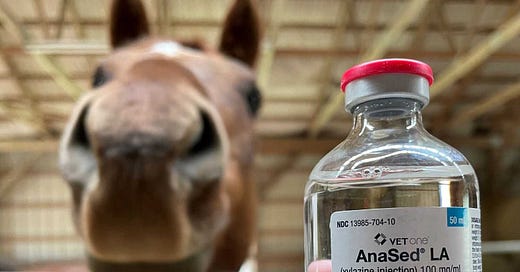Rotting From the Inside Out: Lethal Xylazine Intensifies the U.S Drug Crisis
When it comes to addiction, xylazine is the newest star on the block. Xylazine or “tranq,” as it is known on the street, is a powerful animal tranquilizer increasingly being found as an added adulterant in the illicit fentanyl supply. A 2021-2022 study out of Maryland found that xylazine was present in almost 80% of illicit drug samples containing opioids. Since it is harder to detect and not included in most routine drug testing strips, xylazine is now also being used to spike alcoholic drinks, leaving victims extremely sedated (and vulnerable).
Most folks using fentanyl are unaware that they are also consuming xylazine: tranq is an uninvited and most unwelcome guest. A study published in the April 2024 Journal of Addiction Medicine found that approximately 74% of drug users in Philadelphia did not know that xylazine was in the fentanyl they consumed.
What exactly is xylazine? Why is it in the American drug supply? What makes it so dangerous? Why should you care? And what can you do? Let’s dive in.
Xylazine is what we call a “central alpha two agonist;” this means that it attaches to “alpha” receptors centrally located close to the heart to cause significant sedative effects. Legally, xylazine is used by veterinarians to sedate horses and large cattle. The most prominent physical effects include decreased blood pressure, decreased heart rate, and pronounced somnolence. Cartels add xylazine to illicit fentanyl to prolong the addictive “euphoria” or high that comes from opioids. Fentanyl is already a very powerful depressant that decreases heart rate, respiration, and alertness. When you add xylazine to the party, these dangerous sedative effects are magnified. It is thus more addictive, and much more deadly.
When treating an overdose victim, how do medical providers know if the overdose came from fentanyl alone or xylazine laced fentanyl? (Overdose victims are usually unconscious, and they would likely be unaware of the Xylazine addition anyway.) Most notably, heart rate and blood pressure are typically much lower with a fentanyl-xylazine consumption as opposed to fentanyl alone. Normal heart rate range is between 60-100 beats per minute. Fentanyl overdoses usually reduce this number to 45-60 beats per minute. A fentanyl-xylazine combo can reduce the heart rate down to as low as 30-40 beats per minute. Narcan is used to reverse both kinds of overdose.
Perhaps worse of all, Xylazine use causes pronounced wounds that literally rot your skin from the inside out. I know. It sounds like a bad eighties Zombie flick come to life. If left untreated, these “tranq wounds” can lead to infection, necrosis, skin death, and potential amputation. The flesh-rotting wounds give off a powerfully foul odor and eventually turn black with skin death. Just google “xylazine skin wounds” after reading this article if you want a visual. It’s pretty horrific.
Most superficial wounds start externally with initial insult to the skin surface. In contrast, “tranq wounds” begin internally, below the surface of the skin, slowly progressing outward to skin surface. This happens because Xylazine causes pronounced constriction (narrowing) of peripheral blood vessels. The narrowing of these surface blood vessels prevents regular blood flow and oxygen delivery, thus slowly causing skin death from the inside out. Let me repeat that again: You rot from the inside out. So disturbing.
Xylazine is also increasingly being found in spiked alcohol drinks. It is a clear liquid. It is also not included in most traditional drug testing strips. Thus, it is easy to disguise in drinks and hard to test for. Victims are left extremely sedated and vulnerable. Victims of xylazine spiked drinks often describe seeing a subtle, clear, oily looking film floating near the edges of the top of their drink.
Xylazine’s debut on the illicit drug scene inevitably makes drug and alcohol use more deadly. The stakes are higher. Now, not only can you get addicted to drugs. You can get addicted to drugs that will rot your leg off at the same time. There are a few newer companies that make drug test strips for both fentanyl and xylazine detection. If you or someone you know struggles with opioid use or unsafe alcohol use, make sure to buy drug testing strips that test for both fentanyl and xylazine.
Xylazine will certainly not be the last adulterant added to fentanyl. There will be more. But it is certainly the scariest thus far. Xylazine arrival brings a new level of well-deserved angst, fear, and horror to the drug landscape. It also brings opportunity. My hope is that we harness this fear to fuel our resolve to end the opioid crisis once and for all, increasing access to treatment for those who need it most.





